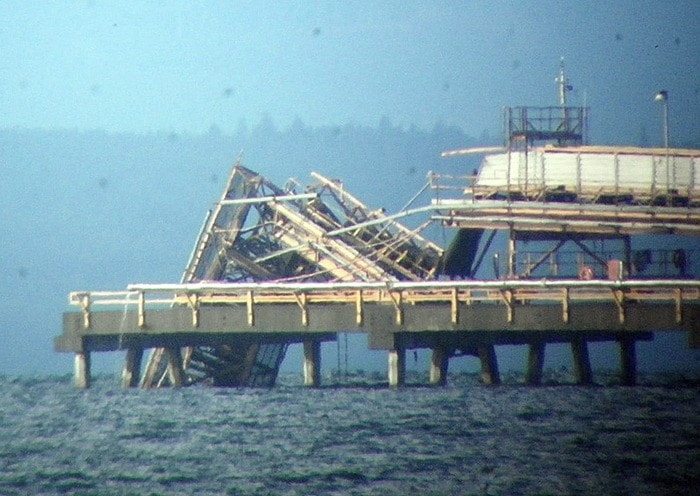Westshore Terminals is alleging the freighter that crashed into its coal conveyer on Dec. 7, causing 35 tonnes of coal to spill into the ocean, was being operated in a "negligent manner," by her owners, master, pilot and crew, and failed to obey marine laws.
A statement of claim was filed by Westshore Terminals in B.C. Supreme Court the same day as the accident, seeking general damages, interest and costs, the extent to which is as yet unknown.
Nick Desmarais, secretary of Westshore Terminals Investment Corporation, said the civil suit is a matter of routine course to protect their legal rights.
The 180,000-tonne Panama-registered Cape Apricot slammed through the coal conveyor at berth one of Westshore Terminals in the early hours of Dec. 7, sending about 150 metres of causeway, trestle, and coal into the ocean.
The lawsuit, which names the owners of the Cape Apricot, Tokei Kaiun Ltd. in Japan, alleges the vessel was "navigated, managed, and operated in a negligent manner…by her owners, master, pilot and crew."
Further, it alleges the vessel failed obey maritime rules, navigate in a safe and prudent manner, approach and dock at the terminal safely, and maintain the vessel in a seaworthy manner.
Tokei Kaiun Ltd have yet to file a statement of defence.
Westshore claims it has and continues to suffer losses, damages and expenses from the damage to the trestle and berth, loss of the use of the berth and accessory revenue, and repairs and other costs associated from the accident.
"[Damages] haven't been calculated yet because we haven't fixed it and we're not back in business," said Desmarais.
Although Westshore is placing the blame solely in the hands of the Cape Apricot, Desmarais said they're still not sure exactly what caused the accident since they haven't been able to interview the pilot yet.
"We'll get our chance and it'll get resolved," he said.
Westshore announced a shareholder payment of $20.4 million will be made by Jan. 15, which represents a $1-million increase from the fourth quarter payment of 2011, despite the accident. The output projections, however, shows Westshore will load 1.1 million fewer tonnes of coal in the fourth quarter of 2012 compared to the year previous.
"We're doing all the right things, we're going to fix it and we'll have our business back running hopefully sooner rather than later," said Desmarais, adding he hopes repairs will be fully completed by the end of March.
Ray Dykes, a spokesman for Westshore Terminals, said the company has just completed salvage of collapsed road section. A large 600-tonne Arctic Tuk crane arrived Dec. 27 to help get the heavier portions of road section out of the water.
A new tressle is being manufactured through Kenron and girders are being fabricated in Portland, Oregon. Pilings are expected to be installed the first week of January.
Meanwhile, the federal body looking into the Dec. 7 crash has upgraded its investigation to a Class 3.
Mohan Raman, a marine investigator with the Transportation Safety Board, said Friday (Dec. 28) a Class 3 investigation is more comprehensive and thorough in finding improvements in marine safety standards.
"We have been collecting information, interviewing the staff on the ship—well, we did and now the ship's gone—and also the personnel that were involved with the docking of the ship," said Raman, adding sorting through everything, assessing responsibility and filing a final report is expected to take up to a year to complete.
There are five investigation classes, according to the TSB website. It states a Class 3 occurrence may be investigated where "there is a significant public expectation that the TSB should independently make findings as to the cause(s) and contributing factors" in the accident and where there is potential for better understanding of latent unsafe conditions.
Raman said he looked at the damage to the bow of the ship which, except for a dent and some paint scrapes, left the coal port relatively unscathed.
"Each accident is looked at independently, since they all have their own uniqueness," said Raman.
